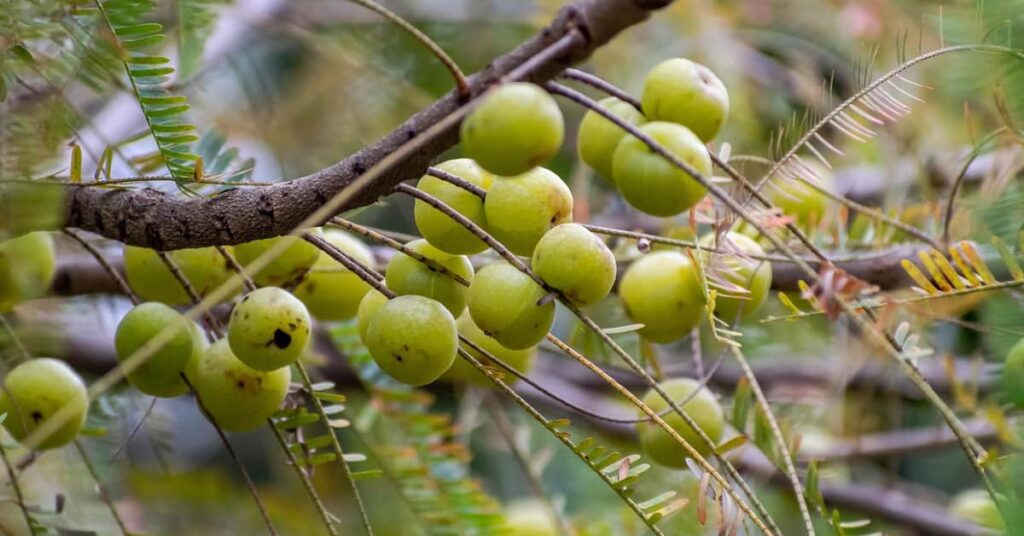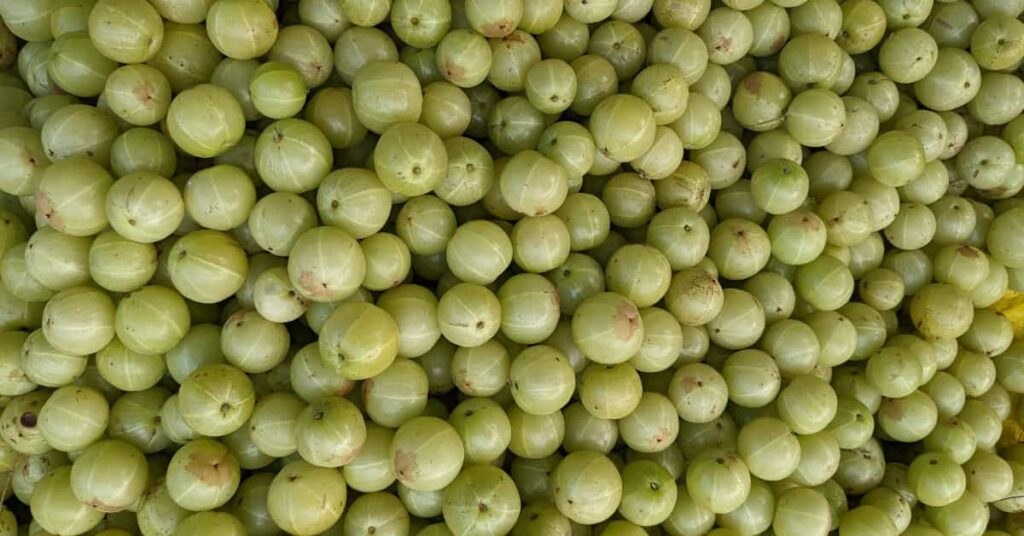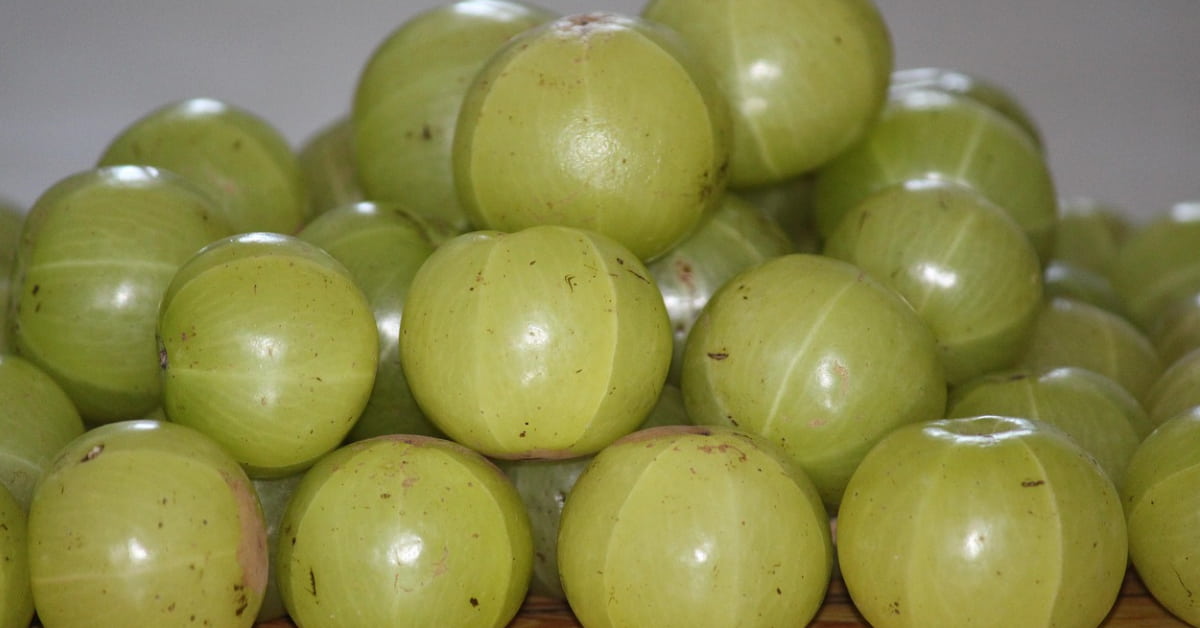Table of Contents
Introduction
Gooseberry is a common name for many species of Ribes, many plants of similar appearance, and several unrelated plants. The berries of those in the genus Ribes are edible and can be green, purple, red, orange, yellow, white, or black.
Gooseberry
Gooseberries are small, nutritious fruits rich in vitamins, minerals, and antioxidants. They may have health benefits, including lower blood sugar, cholesterol, and blood pressure.

Indian Gooseberry
Indian gooseberry has almost as many uses as it has names. It is a food, religious symbol, and cosmetic ingredient.
The tree is also known as āmalakī, amla, emblica, Malacca, and myrobalan.
Medicinal research has investigated the fruits for potential heart, kidney, and liver disease treatments. One Indian gooseberry contains between 600 to 800% of the suggested DV of vitamin C
Gooseberry Nutrition
Gooseberries are low in calories & fat, yet packed with nutrients.
One cup (150 grams) of gooseberries contains:
- Calories: 66
- Protein: 1 gram
- Fat: less than 1gram
- Carbs: 15 grams
- Fiber: 7 grams
- Vitamin B5: 9% of the DV
- Vitamin B6: 7% of the DV
- Vitamin C: 46% of the (DV)
- Copper: 12% of the DV
- Manganese: 9% of the DV
- Potassium: 6% of the DV
Vitamin C is a powerful antioxidant vital to the nervous, immune, and skin systems. Vitamin B5 is compulsory for creating fatty acids; meanwhile, vitamin B6, which many enzymes and cells in the body need to function, helps convert food into energy.
Copper is essential for the heart, blood vessels, brain, and immune system. Manganese supports metabolism, immune response, reproduction, and bone formation, whereas potassium is necessary for normal cell function.
Gooseberry Taste
Gooseberries are primarily known for a tart, sour, and tangy taste, but the flavor can range from sour to slightly sweet depending on the variety and ripeness. They are often described as having a similar flavor to underripe grapes, with a crisp texture. Many people use them in jams, pies, and other dishes, frequently adding sugar to balance the fruit’s natural tartness.
Key Flavor Characteristics
- Sour to Sweet: Tart is predominant, but the fruit can become sweeter as it ripens.
- Tart and Tangy: Many people experience gooseberries as tart and tangy, especially when raw.
- Crisp Texture: Gooseberries typically have a crisp texture, though the skin can be tough to bite into.
- Astringent: Some varieties, particularly Indian gooseberries (Amla), can be astringent, leaving a drying sensation in the mouth.
Variations by Type
- Indian Gooseberry (Amla): Known for being very tart, bitter, astringent, and fibrous, with some pungent and slightly sweet notes underneath.
- European Gooseberry: It can be quite tart or relatively sweet, with a flavor similar to slightly underripe grapes when not fully ripe.
- Cape Gooseberry: Has a bittersweet, tart, and juicy flavor with notes of citrus, pineapple, and cherry.
Gooseberry Plant
Gooseberry is a small spiny bush in the family Rosaceae, that is grown for its eatable fruit of the same name. The gooseberry bush is spiny with deeply lobed, dark green leaves. It produces bell-shaped flowers and green/yellow to red berries approximately 1 inch long, containing many tiny seeds.
If appropriately managed, gooseberry bushes can be very long-lived. It can be eaten fresh or used as an ingredient in another foods for example desserts, jams & preserves, and drinks like tea. The fruit may also be used as an ingredient for pickling. They are also used to flavor beverages like sodas, flavored waters, or milk, and may be made into fruit wines and teas. They can be preserved in the form of jams or dried fruit.

Cape Gooseberry
A cape gooseberry is a small, orange-yellow fruit with a tangy, sweet-tart flavor, encased in a delicate, papery husk. It belongs to the same family as tomatoes and eggplants, also known as goldenberry, physalis, or rasbhari in India. The fruit contains vitamins A and C, antioxidants, and dietary fiber, offering immunity, eye health, and digestive benefits.
Key Characteristics
- Appearance: Small, round, vibrant yellow-orange fruit inside a papery, husk-like covering.
- Botanical Family: Solanaceae, like tomatoes, peppers, and eggplants.
- Flavor: A unique sweet-tart taste that makes it a versatile ingredient.
Nutritional Benefits
- High in Vitamins: A good source of vitamin C, that supports the immune system & skin health, and vitamin A.
- Rich in antioxidants: These compounds help fight cell damage.
- Dietary Fiber: Aids in digestion & promotes overall digestive health.

Gooseberry benefits
1. Strengthens the Immune System
One of the main benefits of gooseberry juice is that it can strengthen your immune system remarkably. A 100g (i.e., approximately half a cup) serving of diced gooseberries can offer 300mg of Vitamin C — an amount which is almost double the amount suggested daily for adults. Vitamin C and other beneficial compounds like alkaloids, polyphenols, and flavonoids act as excellent immune boosters.
2. Protects Cardiovascular Health
The fruit may safeguard cardiovascular health by decreasing LDL (low-density lipoprotein) levels and increasing HDL (high-density lipoprotein) levels, which minimizes the risk of heart attacks.
3. Prevents Neurodegenerative Diseases
Intake of gooseberry juice or gooseberry powder may significantly decrease inflammation. The fruit’s anti-inflammatory properties help prevent the onset of neurodegenerative diseases like Alzheimer’s, Parkinson’s, and Motor Neuron Disease.
4. Manages Diabetes
Consumption of gooseberry fruit or its juice can help manage Diabetes effectively. The soluble fibres in the fruit dissolve easily, thereby controlling the body’s sugar absorption rate. This phenomenon prevents sudden sugar spikes, which are common in individuals coping with Diabetes. Furthermore, research has shown that drinking amla juice daily in the morning can favourably impact the lipid and blood glucose counts in patients with type 2 diabetes.
5. Prevents Cancer
One of the most remarkable benefits of gooseberry juice or fruit is that it can increase longevity by preventing certain deadly diseases like cancer. Studies, though limited, show that gooseberries can destroy cancer cells in the case of certain types of carcinoma. These include carcinoma of the lungs, breasts, ovaries, and cervix.

6. Improves Eye Health
Vitamins A and C, the two vital nutrients in gooseberries, may protect your eyes from issues like weak vision and age-related macular degeneration. Vitamin C may also prevent eye infections like conjunctivitis or pink eye.
7. Improves Skin Health
One of the most well-known benefits of gooseberry juice and fruit is that it can give you radiant skin. Drinking the juice daily in the morning can flush out toxins from your system, giving you flawless skin. Researchers have also declared that topical application of fresh gel extracted from the gooseberry fruit can eliminate ageing signs like wrinkles, fine lines, loss of skin elasticity, and hydration.
8. Improves Digestive Health
Gooseberry fruit is excellent for digestive health. Consuming it can stimulate the secretion of various digestive enzymes, thereby improving digestive power. The fruit’s fibre can regulate bowel movements, alleviating constipation and irritable bowel syndrome.
9. Easy to add to your diet
For maximum health benefits, it’s best to enjoy gooseberries raw.
You should wash and prepare the berries before eating them. Most people prefer to chop the very bottom and top off the berry, as the latter can taste a little woody.
Once prepared, gooseberries are a healthy snack. You may add them to a fruit salad, use them as a topping on yogurt or cereal, or mix them into a fresh summer salad.
Gooseberries are also used in cooked and baked dishes, like pies, chutneys, tarts, compote, jams, and cordial. However, these dishes often contain sugar, and cooking destroys many antioxidants and beneficial phytonutrients.
Side effects
Gooseberry (amla) side effects can include digestive issues like constipation, bloating, and hyperacidity, due to its high fiber and acidic content. It can also lead to hypoglycemia by lowering blood sugar and increasing the risk of bleeding by thinning the blood. Additionally, excessive consumption can cause dehydration, tooth enamel erosion, and allergic reactions.
Digestive Issues
- Constipation: The astringent tannins in amla may dry out the intestinal lining and harden stools, especially with insufficient water intake.
- Bloating: The high fiber and natural sugars can ferment in the gut, creating gas and bloating, particularly in people with sensitive stomachs.
- Hyperacidity: Amla’s high acidity and Vitamin C can trigger or worsen acid reflux and acidity in some individuals.
Blood Sugar and Blood Pressure
- Hypoglycemia: Amla can stimulate insulin release, potentially leading to dangerously low blood sugar levels, mainly in people with Diabetes or taking medication.
- Interactions with Medication: It can interact with blood-thinning and diabetes medications, affecting blood clotting and glucose metabolism.
Other Side Effects
- Tooth Enamel Erosion: The highly acidic nature of amla and its ascorbic acid (Vitamin C) can soften and weaken tooth enamel with frequent consumption.
- Allergic Reactions: Many individuals may experience itching, hives, rash, nausea, cramping, swelling, or difficulty breathing after consuming amla.
- Dehydration: Amla is a natural diuretic, and excessive consumption can lead to fluid loss and symptoms like skin dryness.
- Pregnant or Breastfeeding Women:
- There isn’t enough reliable information to determine safety; consult a healthcare provider.
Who Should Be Cautious
- People with Existing Conditions: Those with low blood sugar, kidney issues, sensitive stomachs, or a history of hyperacidity should exercise caution.
- Pregnant or Breastfeeding Women: There isn’t enough reliable information to determine safety; consult a healthcare provider.
- Individuals on Medication: People taking blood thinners, diabetes medications, or aspirin should consult a doctor before consuming gooseberries.
Conclusion
Gooseberries are tart fruits high in nutrients, like vitamin C. It has many potential health benefits, including anti-aging, antioxidant, and anti-carcinogenic properties.




